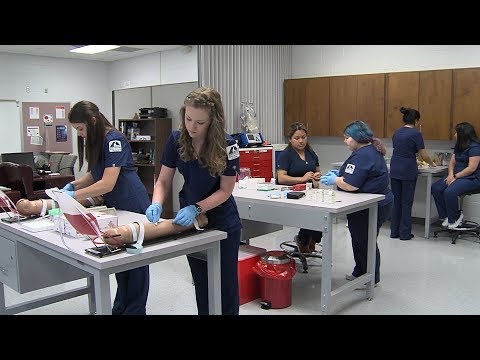What’s the Difference Between a Medical and Nursing Assistant?
Contents [show]
If you’re considering a career in the medical field, you may be wondering what the difference is between a medical and nursing assistant. Both roles are important in providing patient care, but there are some key differences between the two. Here’s a look at the main differences between medical and nursing assistants.
Checkout this video:
Job duties of medical and nursing assistants
The job duties of medical and nursing assistants can vary depending on the state in which they work and the specific facility in which they are employed. However, there are some similarities between the two positions. Both medical and nursing assistants typically provide basic patient care, take vital signs, collect and process lab samples, schedule appointments and provide administrative support to the medical staff. In some states, Medical assistants may also be allowed to perform more advanced procedures, such as suturing wounds or giving injections. Nursing assistants typically have more training than Medical Assistants and their job duties may include providing direct patient care, such as bathing and feeding patients, or They may also work in long-term care facilities where they provide basic nursing care to residents.
Education requirements
medical assistants and nursing assistants are both important members of the healthcare team. They both provide basic patient care and perform administrative tasks, but there are some key differences between the two roles.
One difference is in the education requirements. medical assistants typically have a postsecondary certificate or diploma, while nursing assistants must complete an accredited training program. Nursing assistants also must pass a competency exam before they can be certified.
Another difference is in the scope of practice. medical assistants can perform a wider range of tasks, including taking patient medical histories and administering medications, while nursing assistants are limited to tasks that do not require medical training, such as bathing and feeding patients.
Medical assistants typically work in doctors’ offices, while nursing assistants work in long-term care facilities such as nursing homes or hospitals. Finally, pay is another difference between these two roles. Medical assistants earn a median salary of $33,610 per year, while nursing assistants earn a median salary of $28,530 per year.
Salary comparison
Although medical and nursing assistants perform many of the same duties, there are some key differences between the two professions. Medical assistants typically have more clinical responsibilities, such as taking vital signs and administering injections, while nursing assistants generally have more hands-on patient care duties, such as bathing and dressing patients.
When it comes to salary, medical assistants tend to earn a bit more than nursing assistants. According to the Bureau of Labor Statistics, the median annual salary for medical assistants was $32,480 in 2018, while the median annual salary for nursing assistants was $28,540.
Job outlook
Both medical and nursing assistants are in high demand. Employment of medical assistants is projected to grow 19 percent from 2019 to 2029, much faster than the average for all occupations.1 The size of the aging baby-boom generation is increases the need for medical services. As a result, physicians will hire more medical assistants to perform routine administrative and clinical duties, allowing the physicians to see more patients.
Nursing assistants are expected to see a 11 percent job growth from 2019 to 2029.2 The aging population will continue to drive demand for nursing assistants in long-term care settings. Increasing numbers of people with chronic conditions, such as diabetes and obesity, will also require more nursing assistant services as they age.
Career paths
Medical and nursing assistants are both vital members of the healthcare team, but they have different roles to play. Here’s a quick overview of the key differences between these two career paths.
Medical assistants are trained to perform both administrative and clinical tasks in a medical office. They might handle scheduling appointments, billing, and insurance paperwork, as well as taking medical histories and recording vitals. They might also assist with minor office procedures, such as giving injections or removing stitches.
Nursing assistants provide basic patient care under the supervision of a registered nurse. They might help with bathing, dressing, and eating; take vital signs; or provide emotional support to patients and their families. Nursing assistants who work in long-term care facilities might also help with more personal tasks such as turning and repositioning bedridden patients.
Similarities between medical and nursing assistants
Both medical and nursing assistants perform many of the same duties in healthcare facilities. They both work under the supervision of licensed medical personnel, such as nurses and doctors. Duties may include taking medical histories and recording vital signs, assisting with patient examinations, preparing patients for lab tests and assisting with diagnostic procedures. They also may provide basic patient care, such as bathing and dressing.
Differences between medical and nursing assistants
The duties of a medical assistant are usually more administrative in nature, while those of a nursing assistant are more focused on patient care. Medical assistants typically perform tasks such as scheduling appointments, taking medical histories and recording vital signs. Nursing assistants, on the other hand, may help patients with activities of daily living such as bathing and eating, and they may also provide basic nursing care such as checking oxygen levels and changing dressings.
Working environment
Medical assistants and nursing assistants are both vital members of the healthcare team, but they have very different roles. Medical assistants typically work in outpatient clinics, assisting doctors and other medical staff with patient care. Nursing assistants, on the other hand, work in hospitals or long-term care facilities, providing direct patient care under the supervision of licensed nurses.
Both medical assistants and nursing assistants must be compassionate and able to communicate effectively with patients. They must also be able to follow instructions carefully and work well as part of a team. However, medical assistants generally need less formal training than nursing assistants, as they are not responsible for tasks that require direct patient contact, such as bathing or dressing patients.
Necessary skills
There are several key skills that are necessary for both medical and nursing assistants. These include the ability to communicate effectively with patients, families, and other healthcare providers; excellent organizational skills; and the ability to multitask. In addition, both medical and nursing assistants must have the ability to work well under pressure and handle stressful situations.
However, there are also some key differences between medical and nursing assistants. Medical assistants typically have more clinical duties, such as taking patients’ vital signs and performing minor medical procedures. Nursing assistants, on the other hand, typically have more hands-on duties, such as bathing and feeding patients.
Personality traits
Working as a medical or nursing assistant requires a unique combination of clinical skills and people skills. Medical and nursing assistants must be able to perform vital tasks such as measuring vital signs, administering injections and taking medical histories; however, they also play an important role in comforting patients and providing emotional support.
While both medical and nursing assistants need to be compassionate and have strong communication skills, there are some personality traits that are more important for each position.
Medical assistants are often the first point of contact for patients when they come into a healthcare facility. As such, they need to have excellent customer service skills and be able to defuse tense situations. They also need to be able to handle a high volume of work with speed and accuracy.
Nursing assistants typically work more closely with patients than medical assistants do. They need to be patient and calm, as well as have the physical stamina to deal with lifting and moving patients. Nursing assistants also need to be comfortable working in shift patterns that may include evenings, weekends or overnight shifts.





